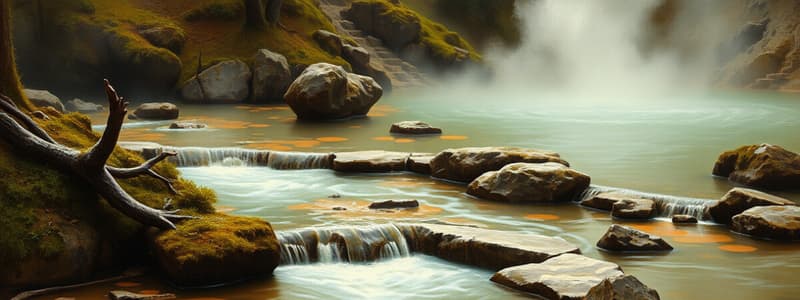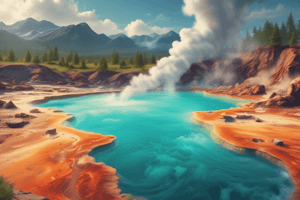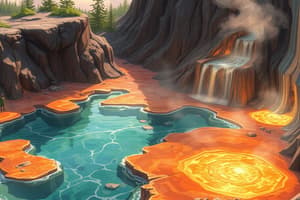Podcast
Questions and Answers
What primarily heats the water in hot springs?
What primarily heats the water in hot springs?
- Geothermal energy from beneath the Earth's surface (correct)
- Chemical reactions in the atmosphere
- Wind energy generated by surface currents
- Solar energy from the sun
Which type of mountain forms when magma pushes up through the lithosphere?
Which type of mountain forms when magma pushes up through the lithosphere?
- Fault-block mountains
- Volcanic mountains
- Folded mountains
- Dome mountains (correct)
Which feature is typically formed by acidic standing water that dissolves surrounding rock into clay?
Which feature is typically formed by acidic standing water that dissolves surrounding rock into clay?
- Hot spring
- Volcano
- Mud pot (correct)
- Geyser
What geological phenomenon occurs when tectonic plates push into each other?
What geological phenomenon occurs when tectonic plates push into each other?
How do bacteria on the ocean floor generate energy?
How do bacteria on the ocean floor generate energy?
What is the primary factor that determines climate in an area?
What is the primary factor that determines climate in an area?
Which type of front occurs when neither air mass moves?
Which type of front occurs when neither air mass moves?
What is the role of meteorologists?
What is the role of meteorologists?
What are the three stages of a thunderstorm?
What are the three stages of a thunderstorm?
What typically indicates the formation of a tornado?
What typically indicates the formation of a tornado?
What are the three types of weathering?
What are the three types of weathering?
Which of the following types of erosion is caused by glaciers?
Which of the following types of erosion is caused by glaciers?
What type of rock is formed through cooling and crystallization of magma?
What type of rock is formed through cooling and crystallization of magma?
What is the process by which soil is formed?
What is the process by which soil is formed?
Which characteristic describes the shininess of a rock?
Which characteristic describes the shininess of a rock?
What are voestsects created by wind erosion called?
What are voestsects created by wind erosion called?
What is 'rill erosion' primarily caused by?
What is 'rill erosion' primarily caused by?
What are the three types of sedimentary rocks?
What are the three types of sedimentary rocks?
Which part of the water cycle involves water turning from a liquid to a gas?
Which part of the water cycle involves water turning from a liquid to a gas?
What type of clouds are characterized by being puffy and white, resembling cotton balls?
What type of clouds are characterized by being puffy and white, resembling cotton balls?
Solar radiation includes which of the following types of light?
Solar radiation includes which of the following types of light?
What instrument do meteorologists use to measure wind speed?
What instrument do meteorologists use to measure wind speed?
What happens during a high pressure weather system?
What happens during a high pressure weather system?
Which air mass is associated with warm and humid conditions?
Which air mass is associated with warm and humid conditions?
What is it called when warm, humid air rises and cools, causing water vapor to condense into droplets?
What is it called when warm, humid air rises and cools, causing water vapor to condense into droplets?
Which type of cloud is likely to produce thunderstorms or snow when it forms?
Which type of cloud is likely to produce thunderstorms or snow when it forms?
What defines the state of weather at any given time?
What defines the state of weather at any given time?
Flashcards are hidden until you start studying
Study Notes
Hot Springs and Geothermal Energy
- Hot springs are natural water springs heated by geothermal energy from Earth's interior.
- Typical temperatures range, but some can exceed normal hot spring temperature.
- Most hot springs are created when rain or groundwater seeps into the Earth, collecting in underground reservoirs.
- Groundwater is heated by magma, causing it to rise and form hot springs through faults in the Earth's crust.
- Geysers are hot springs that intermittently eject steam and boiling water.
- Mud pots form in acidic conditions, where standing water dissolves surrounding rock.
Mountain Formation
- Mountains form from the lithosphere, composed of the crust and deep rock layers.
- Tectonic plates push and pull against each other, leading to various mountain types:
- Dome mountains arise when magma pushes the crust upwards.
- Volcanic mountains form at small vents in the lithosphere.
- Fault-block mountains result from crustal cracking and shifting.
- Folded mountains occur when two tectonic plates collide.
Ocean Floor Characteristics
- The ocean floor features volcanoes, trenches, and mountains similar to land.
- Hydrothermal vents are areas of warm water and chemically-rich environments.
- Bacterial life at the ocean bottom derives energy from chemicals rather than sunlight.
Topography and Maps
- Topography is the study of land's physical features.
- Topographic maps utilize contour lines to represent elevation changes.
- The density of contour lines indicates the steepness of terrain: closer lines mean greater elevation change.
Weathering Processes
- Weathering breaks down rocks into smaller pieces, categorized into three types:
- Mechanical weathering physically breaks rocks apart.
- Chemical weathering alters rock chemically, such as oxidation.
- Organic weathering involves biological organisms aiding decomposition.
Erosion Dynamics
- Erosion involves the movement of soil and debris by natural forces like water, ice, and wind.
- Types of water erosion include:
- Inter-rill erosion: small craters form from raindrops.
- Rill erosion: small channels form in soil.
- Gully erosion: large channels develop from runoff.
- Streambank erosion: large bodies of water reshape land over time.
- Human activity, such as deforestation, exacerbates erosion issues.
Wind Erosion Types
- Wind erosion consists of the movement of materials lifted or rolled by air.
- Types include:
- Creep: larger particles roll along the ground.
- Saltation: particles bounce along the surface.
- Suspension: small particles remain airborne.
- Aeolian landforms, like sand dunes and yardangs, result from wind erosion.
Glacial Formation
- Glaciers are massive ice formations formed from compressed snow and ice.
- Two main types: alpine glaciers in mountain regions and continental glaciers that cover large land areas.
- Present on all continents except Australia, with significant concentrations in Antarctica and Greenland.
Soil Composition
- Soil is formed from the breakdown of rocks mixed with organic materials.
- Different soil types and horizons exist below the surface, hosting various organisms like earthworms that enrich soil nutrients.
Rock Properties
- Rocks are composed of minerals with various characteristics, including streak color and luster.
- Other properties include hardness, texture, shape, and size.
Rock Cycle Overview
- The rock cycle illustrates how rock material transitions between forms: igneous, sedimentary, and metamorphic.
- Igneous rock forms from cooled magma or lava.
- Sedimentary rock forms from compressed sediments.
- Metamorphic rock results from heat and pressure changes.
Weather Cycle Essentials
- The water cycle encompasses evaporation, condensation, precipitation, and collection of water.
- Evaporation occurs when water transforms into gas; condensation changes gas back to liquid, leading to precipitation.
- Collection refers to water gathering in various environments like lakes and oceans.
Cloud Types
- Four main cloud types exist:
- Cumulus: puffy and white.
- Stratus: flat and gray.
- Alto: made of water and ice droplets.
- Cirrus: wispy, usually indicating fair weather.
Solar Radiation Importance
- Solar radiation consists of sunlight and energy traveling to Earth as light waves.
- It includes visible light, infrared for heat, and ultraviolet (UV) light, which can harm skin.
Wind Movement and Measurement
- Wind results from air pressure differences, influenced by sunlight’s uneven heating of land and water.
- Wind speed can be measured by instruments like an anemometer and assessed on the Beaufort scale.
Air Pressure and Weather Predictions
- Air pressure affects weather, with high pressure typically bringing clear skies, while low pressure correlates with clouds and precipitation.
- Meteorologists study air pressure to make weather predictions.
Air Mass Characteristics
- Air masses acquire temperature and humidity traits from their formation locations.
- Six major types of air masses include maritime tropical and continental polar.
- Air masses impact weather as they move, especially at frontal boundaries, where they may collide and cause precipitation.
Weather and Climate Definitions
- Weather is the atmospheric state at a specific time, influenced by solar energy.
- Climate is defined by long-term weather patterns, affected by factors like temperature, elevation, and proximity to water bodies.
Atmosphere Study and Weather Maps
- Meteorologists track weather using maps, providing forecasts that inform daily activities.
- Weather maps can display satellite imagery, precipitation, temperature, and more.
Understanding Fronts
- Fronts occur when two air masses meet and can lead to various weather phenomena.
- Types of fronts include cold fronts, warm fronts, stationary fronts, and occluded fronts.
Tornado Insights
- Tornadoes are violent windstorms characterized by a rotating column of air.
- They form in thunderstorms when cold and warm air interactions occur, particularly prevalent in Tornado Alley in the U.S.
Hurricane Characteristics
- Hurricanes are massive storms powered by warm ocean waters, exhibiting wind speeds of 74 to 200 mph.
- They are marked by a central calm zone known as the eye.
Thunderstorm Development
- Thunderstorms require moisture, unstable air, and lift.
- They progress through three stages: developing, mature, and dissipating, often most active in the afternoon.
Lightning Formation
- Lightning results from electrical discharge during storms, with several types including cloud-to-ground.
- It is a dangerous phenomenon that requires users to seek shelter indoors.
Ecosystem Fundamentals
- Ecosystems consist of living organisms and non-living components in both aquatic and terrestrial environments.
- Food chains represent energy transfer: producers, primary and secondary consumers, and decomposers.
Energy Pyramid Concept
- The energy pyramid illustrates energy transfer and flow among organisms within a food chain.### Energy Pyramid and Food Chain
- Four main levels: producers, primary consumers, secondary consumers, and tertiary consumers.
- Producers (plants) utilize solar energy through photosynthesis, converting it into glucose for food.
- Primary consumers rely on producers for nourishment, eating plants.
- Secondary consumers feed on primary consumers, while tertiary consumers are top predators in the ecosystem.
- Energy availability decreases as one moves up the energy pyramid, reflecting the inefficiency of energy transfer between trophic levels.
Global Warming
- Global warming leads to an increase in Earth's temperature, primarily driven by human activities.
- Key contributors include vehicle emissions, fossil fuel burning, industrial activities, and agricultural practices.
- Increased greenhouse gases in the atmosphere trap heat, causing temperatures to rise.
Pollution
- Pollution negatively impacts land, water, and air quality, affecting all living organisms.
- The harmful effects of pollution extend to humans, wildlife, and plant life.
- Individual choices in shopping, waste disposal, and transportation influence pollution levels.
- Adopting eco-friendly practices can contribute to a cleaner and healthier environment.
Studying That Suits You
Use AI to generate personalized quizzes and flashcards to suit your learning preferences.




